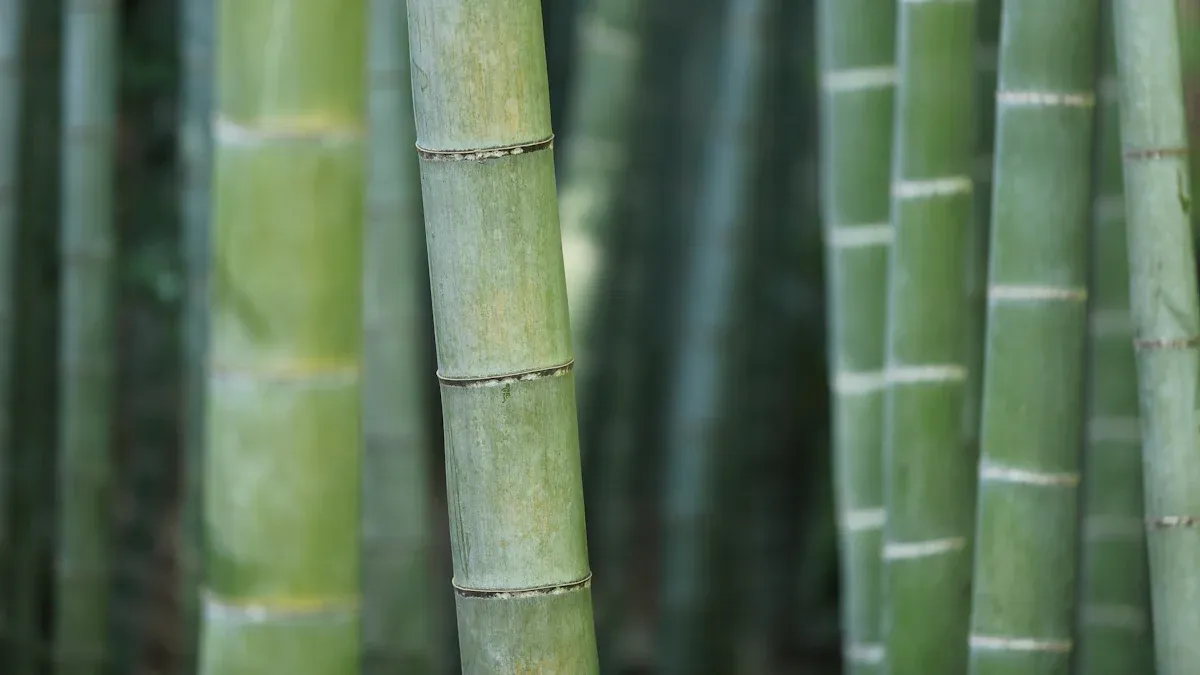
Bamboo fabric is a natural choice for allergy sufferers. It has special features that make it hard for dust mites to live. For example:
- The fabric pulls moisture away, stopping bacteria and fungi from growing.
- Its tight weave blocks dust mites from reaching food like dead skin.
Research shows bamboo fabric absorbs 60% more moisture than cotton. This keeps bedding dry and less friendly to allergens. Plus, its antibacterial quality cuts bacteria by up to 97%, making it better for sensitive skin.
Key Takeaways
- Bamboo fabric is naturally gentle and great for people with allergies. Its soft fibers help avoid skin irritation and feel comfortable.
- Bamboo soaks up 60% more water than cotton. This keeps bedding dry and less attractive to dust mites. It helps create a healthier place to sleep.
- Bamboo fabric kills up to 97% of bacteria. This makes it good for sensitive skin and helps stop skin problems.
- Pick good-quality bamboo products with trusted labels for safety and the environment. Look for tags like OEKO-TEX and Forest Stewardship Council.
- Take care of bamboo fabric by washing gently and air drying. Cleaning it often keeps it fresh and keeps its allergy-friendly benefits.
Why is bamboo fabric dust mite resistant?

Natural hypoallergenic properties
Bamboo fabric feels soft and gentle on the skin. Its smooth fibers don’t cause irritation, making it great for sensitive skin. A study in “Dermatology Reports” found that people with skin issues, like eczema, had fewer problems using bamboo fabric. The fibers are round and smooth, unlike rougher materials that can bother the skin. Research also shows bamboo fabric reduces bacteria by 97%, helping to stop skin irritation.
Many people love switching to bamboo products. For instance, Mark said bamboo pajamas improved his sleep. He no longer feels itchy because of the fabric’s hypoallergenic features. Emma, a mom, uses bamboo baby clothes for her newborn. She likes how soft and antibacterial they are. These stories and studies show bamboo fabric helps skin stay healthy and lowers allergens.
Moisture-wicking capabilities
Bamboo fabric pulls moisture away, keeping things dry and fresh. I’ve noticed it works well even on humid nights. Research shows bamboo absorbs 40% more moisture than cotton. This stops dampness, which dust mites need to survive.
Here’s a simple comparison:
| Fabric | Absorbency Level | Evaporation Rate | Temperature Control |
|---|---|---|---|
| Bamboo | 60% more than cotton | Faster | 2-3°F cooler |
| Cotton | Standard | Slower | Standard |
This table shows how bamboo fabric keeps you cool and dry. Sweat dries faster, and less moisture stays on your skin. This makes it hard for dust mites to live.
Antimicrobial qualities
Bamboo fabric has bamboo kun, a natural compound that fights germs. It helps stop bacteria, fungi, and viruses from growing. This is very useful for bedding and clothes. Studies show bamboo kun can cut bacteria by up to 99.8%. Even after 50 washes, bamboo fabric keeps 70% of its antibacterial power.
Tests by the Japan Textile Inspection Association confirm this. Bamboo fabric stays clean and hygienic over time. Its germ-fighting ability keeps dust mites away and makes your space healthier.
Benefits of bamboo fabric for allergy sufferers
Breathable and temperature-regulating
Bamboo fabric helps you stay comfy, even on hot nights. Its fibers have tiny holes that let air pass through. This makes it 20% more breathable than cotton. Better airflow means less skin irritation for people with allergies. Bamboo fabric also soaks up 60% more moisture than cotton. It can hold three times its weight in water. Sweat dries faster, keeping the fabric cool and dry.
Bamboo sheets feel cooler than other fabrics. Studies show they stay 2-3°F cooler than the air around them. This is great for people who sleep hot or live in humid places. Many people love bamboo fabric for its smooth feel and moisture-wicking ability. It’s perfect for staying comfy and keeping dust mites away.
Eco-friendly and chemical-free
Bamboo is a very sustainable plant. It grows fast and needs little water or pesticides. But not all bamboo fabric is made the same way. Some methods use harmful chemicals like carbon disulfide and sodium hydroxide. These can hurt the environment and workers. Look for labels like “Bamboo Linen” or “Lyocell Bamboo” for safer options.
The lyocell process is better because it reuses water and chemicals. This makes it safer for the planet. Bamboo fabric is known for being eco-friendly, but you should choose carefully. Picking the right products helps you avoid fake claims about sustainability. By choosing wisely, you can help yourself and the Earth.
How to pick the best bamboo fabric products
Finding good bamboo fabric products can seem tricky. But, I’ve learned some simple tips to help. Great bamboo fabric is strong, comfy, and eco-friendly. Here’s how to choose wisely.
Check material quality
The quality of bamboo fabric depends on its material. I always look for products tested for safety and performance. For example:
- Chemical Composition Testing: Makes sure the fabric has no harmful chemicals like pesticides.
- Physical and Mechanical Testing: Checks strength and moisture-wicking ability for long-lasting use.
- Microbiological Testing: Tests for mold resistance and germ-fighting properties, great for humid areas.
- Environmental Testing: Confirms the fabric is biodegradable and eco-friendly.
These tests ensure the fabric is safe for sensitive skin and works well over time.
Look for trusted certifications
Certifications help you trust the bamboo fabric you buy. I always check for labels from reliable groups. Here’s a quick list:
| Certification Body | What It Ensures |
|---|---|
| Forest Stewardship Council | Promotes sustainable practices and protects nature and communities. |
| Verified Carbon Standard (VCS) | Certifies low greenhouse gas emissions and supports carbon storage. |
| OEKO-TEX | Guarantees fabrics are free from harmful chemicals and safe for skin contact. |
These certifications show the product is safe and eco-friendly. I’ve noticed OEKO-TEX fabrics feel softer and more dependable.
Think about the product’s use
Different bamboo products work for different needs. I always consider what I need before buying. For example:
- Bedding: Pick tightly woven sheets to keep dust mites away.
- Clothing: Choose light, breathable fabrics for everyday comfort.
- Towels: Go for thicker towels to absorb more water.
Good bamboo fabric feels smooth and lasts longer. Learning about how it’s made also helps. Processes like lyocell are better for the planet and make higher-quality fabric.
By using these tips, I’ve found bamboo products that are comfy, durable, and eco-friendly.
Tips for maintaining bamboo fabric
Proper washing techniques
Washing bamboo fabric correctly helps it last longer. Use a mild detergent without strong chemicals, dyes, or scents. This keeps the fabric safe for sensitive skin. For delicate items, hand wash them. Soak in cool water with detergent, gently swirl, then rinse.
If using a washing machine, pick the delicate cycle with cold water. Put bamboo items in a laundry bag to avoid damage from zippers or rough clothes. These steps keep the fibers smooth and strong.
Tip: Don’t use hot water or bleach. They can shrink and weaken the fabric.
Drying and storage
Drying bamboo fabric the right way is very important. Air drying works best to keep its softness and shape. Hang items on a line or lay them flat. Avoid using a dryer, as it can harm the fibers.
For storage, fold bamboo clothes neatly and store them in a cool, dry spot. Avoid plastic bags or sealed containers, as they trap moisture and cause mildew. Proper drying and storage keep the fabric fresh and ready to use.
Note: Sunlight can fade colors, so dry bamboo items in the shade.
Regular cleaning schedule
Cleaning bamboo fabric often keeps it soft and in good shape. Wash regularly to avoid stains and maintain its quality. Use cold or warm water, as hot water can damage the fibers.
Bamboo fabric naturally fights bacteria and odors, but gentle care is still needed. Careful washing prevents shrinking and pilling. For baby clothes or bedding, clean them often to keep them fresh and comfy.
Reminder: Regular cleaning helps the fabric last longer and stay nice.
Bamboo fabric is great for fighting allergies and dust mites. It has hypoallergenic features and keeps moisture away. This makes your space healthier. Research shows bamboo sheets cut bacteria by 97%. They also stop moisture, which helps reduce allergens. The soft fabric is gentle and perfect for sensitive skin.
If cared for properly, bamboo items can last 12 years. Even after 50 washes, they keep 70% of their germ-fighting power. Picking good bamboo fabric means it will last longer. Taking care of it gives you a cleaner and cozier home.
FAQ
Why is bamboo fabric better for allergies than cotton?
Bamboo fabric soaks up more moisture and dries quicker than cotton. This keeps it dry and less attractive to dust mites. Its hypoallergenic and germ-fighting qualities also lower allergens, making it safer for sensitive skin.
Does bamboo fabric lose its dust mite resistance over time?
No, bamboo fabric stays dust mite resistant with good care. Even after 50 washes, it keeps most of its antibacterial power. Cleaning it often and washing gently helps it stay effective.
Is bamboo fabric okay for babies and kids?
Yes, bamboo fabric is great for babies and kids. Its soft, hypoallergenic fibers stop skin irritation. Many parents pick bamboo clothes and bedding because they’re gentle, breathable, and free of harmful chemicals.
How do I know if bamboo fabric is good quality?
Check for labels like OEKO-TEX or Forest Stewardship Council. These show the fabric is safe and eco-friendly. Good bamboo fabric feels smooth, absorbs moisture well, and lasts a long time.
Does bamboo fabric need special care?
Bamboo fabric needs gentle care to last longer. Wash it in cold water with mild soap. Don’t use bleach or high heat. Air drying keeps it soft and in good shape. Proper care makes it stay strong and useful.
Tip: Always read the care label on bamboo items for details.
